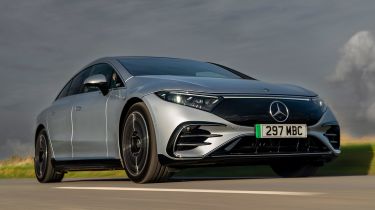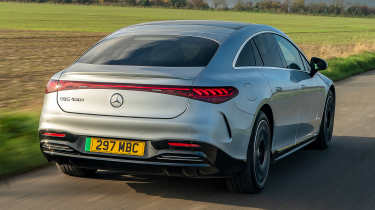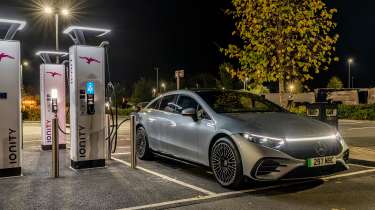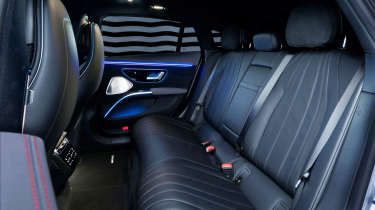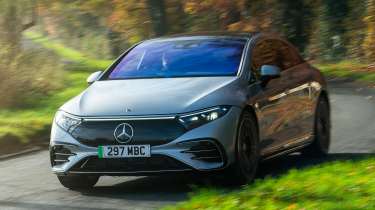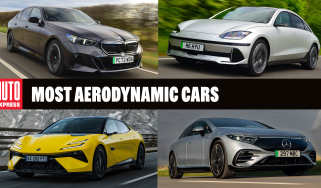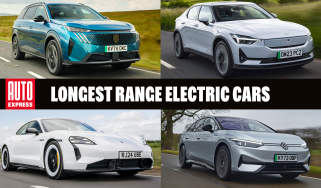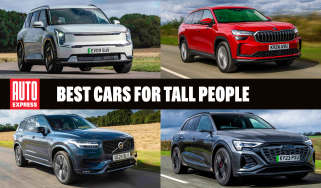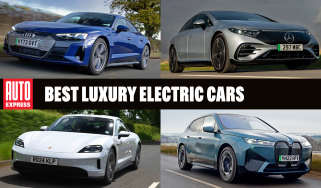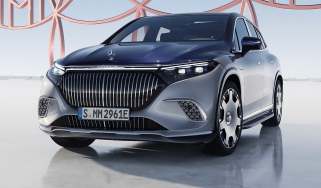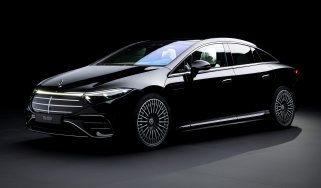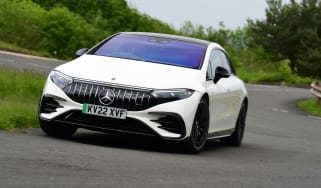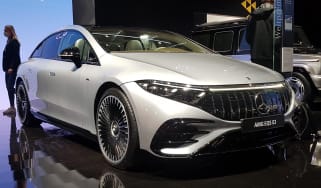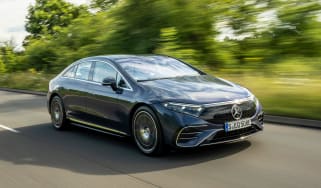Mercedes EQS review
The Mercedes EQS is luxurious and quiet but can’t match rivals from the other German car makers

Is the Mercedes EQS a good car?
The Mercedes EQS is the electric version of the Mercedes S-Class, but somehow it doesn’t feel like it. It doesn’t have the ultimate luxury of the flagship saloon and electric rivals models from BMW and Porsche - the i7 and Taycan - are better in nearly every way. The Mercedes EQS is packed with tech, though, and has a long driving range on a single charge. It makes a lot more sense as a working vehicle for chauffeuring rather than as a private purchase, but perhaps that’s the point; an S-Class is still the better choice if you want a luxury Mercedes.
| Key specs | |
| Fuel type | Electric |
| Body style | Saloon |
| Powertrain | 107.8kWh/single or dual electric motors |
| Safety | 5 stars (Euro NCAP) |
| Warranty | Three years |
How much does the Mercedes EQS cost?
There are three models available in the EQS range, not including the EQS SUV, which is a different car that we’ve reviewed separately. The EQS 350 is the base model and comes in Premium, Premium Plus and Business Class trim levels, then the EQS 450+ is the mid-range car using the same trim levels.
There’s a sporty Mercedes-AMG EQS 53 model with 649bhp at the top of the range, available in Night Edition and Touring trim levels. All models use electric power only with a single-speed automatic, but range and power differs.
The EQS 350 has 288bhp and a range of around 380 to 410 miles depending on trim. It costs around £100,000. The EQS 450+ has 355bhp and 450 to 480 miles of range, while the price ranges from £112,000 to £120,000. The top-spec AMG model costs over £160,000.
Engines, performance & drive
There are three power outputs available for the EQS: 288, 355 and 649bhp. Acceleration is brisk in all models, but the AMG 53 version reaches 0-62mph in just 3.8 seconds. A few years ago that would be a world-shattering figure for a luxury car, but in the 2020s world of £160,000-plus electric cars it’s par for the course.
Used - available now
All versions are good to drive, but even the AMG model is far from the class best when it comes to handling. The Porsche Taycan range is better to drive in all specifications, for example, and we prefer the BMW i7 as well. The EQS has loads of grip, strong acceleration and delivers its performance without sacrificing comfort, but it’s a very heavy car and isn’t all that much fun to drive.
The lesser, non-AMG versions are much more focused on comfort, so they make a lot more sense. Since there’s no expectation of sharp handling, we don’t mind the lack of fun; the soft suspension soaks up bumps brilliantly and is one of the car’s best features. It’s excellent on the motorway, especially since the slippery shape means wind noise is low, and it’s really smooth at high speed.
| Model | Power | 0-62mph | Top speed |
| Mercedes EQS 350 | 288bhp | 6.7s | 130mph |
| Mercedes EQS 450+ | 355bhp | 6.2s | 130mph |
| Mercedes-AMG EQS 53 | 649bhp | 3.8s | 137mph |
Range, charging & running costs
All versions of the Mercedes EQS are fitted with a huge battery pack; even the base model has a 96kWh unit, more than double the size of a typical unit found in a mainstream family electric car. That’s what you expect from a luxury car, but it’s still good to know there’s around 380 miles of range on offer here.
The EQS 450+ model ups that to around 450 miles, which is fantastic and makes the EQS suitable for really long trips. That’s especially true thanks to 200kW fast charging fitted as standard, which means a ten to 80 per cent charge takes around half an hour in all versions. Charging from empty to full at a wallbox charger takes ten hours in the 350 model and 12 in the 450 or Mercedes-AMG 53 versions.
The Mercedes-AMG EQS 53 is the worst for range, as it has more of a performance focus. It can still be charged just as rapidly, but range is the lowest in any EQS at 341 miles. This is still pretty good, as it’s about the same as the high-performance BMW i7 M70 xDrive - and the lesser EQS models beat their BMW equivalents for range, too.
All versions of the EQS sit in insurance group 50, the highest possible group, so don’t expect cheap premiums. Still, if you’re buying a car that costs £100,000 for the entry-level model then that’s probably not an issue for you. Plus, the electric powertrain means you’ll save money on fuel and company car tax compared to an S-Class with a petrol engine in all versions of the EQS.
| Model | Battery size | Range | Insurance group |
| Mercedes EQS 350 | 96kWh | 379-409 miles | 50 |
| Mercedes EQS 450+ | 118kWh | 446-481 miles | 50 |
| Mercedes-AMG EQS 53 | 118kWh | 341-378 miles | 50 |
Design, interior & technology
The Mercedes EQS interior is heavily focused on tech. The first thing you’ll notice is the ‘Hyperscreen’ set-up, which is now standard on all models. It’s a huge 56-inch panel with three screens - one for the driver, a large central one and a further display in front of the passenger seat. It will certainly appeal to tech fans, but cynics might argue that a huge digital screen isn’t as luxurious as a nicely-upholstered dashboard with high-quality materials and switchgear.
The seats are soft and really comfortable, especially those in the front. Unusually for a luxury limo, the rear seats are a little disappointing. Headroom is merely okay - the tallest passengers might feel a bit cramped - mainly because the seats are quite upright. Material quality in the rear isn’t as good as in an S-Class or the BMW i7, although the EQS is still better than lesser Mercedes models such as the EQE.
You can add a Rear Luxury Lounge Pack that brings reclining, massaging seats to the back, but we reckon you shouldn’t have to buy an expensive option pack to make the rear seats feel worth the car’s already huge price tag. Similarly, whatever you think of the exterior design, there’s no question that the EQS looks similar to the lesser EQE; it’s also not as imposing as the BMW i7 nor as sporty as the Porsche Taycan.
Sat-nav, stereo and infotainment
The MBUX Hyperscreen infotainment set-up in the EQS puts even Tesla’s high-end models to shame when it comes to screens. There are three as part of the huge single-piece panel and they can be set up to display the seemingly endless digital features of the EQS.
It’s a bit daunting to dive into but the menu bar with most-used shortcuts means you can access the things you really need quickly enough. There are loads of customisation options so you could spend some time setting it up to be perfect for your needs, then you won’t need to dig through menus when you want to access anything.
The third screen is directly ahead of the passenger, and has its own media controls and a Bluetooth input, meaning the passenger can listen to a different radio station with a set of wireless headphones. In a world of smartphones and earbuds we’re not sure how useful that is, but it’s certainly a talking point.
Boot space, comfort & practicality
| Dimensions | |
| Length | 5,223mm |
| Width | 1,926mm |
| Height | 1,512mm |
| Number of seats | 5 |
| Boot space | 610 litres |
The Mercedes EQS competes in the luxury saloon class, but it doesn’t have a separate boot and cabin, it has a hatchback tailgate. This is great for access but, like in a saloon, the load space is not very high. It’s perfect for suitcases there are certain things (like furniture) that won’t fit despite the 610-litre boot capacity. For people needing more space, there is an EQS SUV that has a hatchback boot with more vertical room.
Still, the EQS has a total of 1,770 litres of space with the seats folded down, which is huge and even better than the boot in the rival Tesla Model S’ - a car known for being spacious.
There’s plenty of space inside and rear legroom is as excellent as you’d expect of a luxury limo. What you wouldn’t expect, though, is that headroom is only okay at best. Tall passengers might find the upright rear seats feel a little cramped for a £100k-plus car. The seats are very comfortable otherwise, though, and the ride quality is excellent.
The EQS is a big car and feels like it on UK roads. At over 1.9m wide and 5.2m long the Mercedes will be too big for many of the UK’s tight multi-storey car parks and even some width restrictors. That’s true of its rivals as well, of course, but if you need a smaller model then there’s always the very similar Mercedes EQE.
Safety & reliability
| Key standard safety features | Euro NCAP safety ratings |
|
|
All versions of the Mercedes EQS are packed with safety tech - as much as you could really want, and without having to add optional extras. Mercedes doesn’t shout about it as loudly as Tesla, but its active lane keep and steering assist tech is - in our experience - better and more relaxing than its rival’s so-called ‘self-driving’ tech for keeping you in your lane on a long motorway trip.
Other safety kit includes a 360-degree parking camera, traffic sign recognition, active collision avoidance and mitigation tech and adaptive high beam assist. The car received an 80 per cent rating from Euro NCAP for safety assist, along with top scores in the other categories and a five-star overall rating.
Reliability should be a high point as well, since electric motors require less maintenance than a petrol or diesel engine. There’s no reason to believe the EQS will be unreliable over a typical ownership period.
The EQS didn’t appear in the Driver Power customer satisfaction survey this year, but parent brand Mercedes ranked poorly in the 2023 manufacturer’s poll, so the ownership experience might not be as good as that of Porsche, which came in 1st that year.
Mercedes EQS alternatives
The main rival for the Mercedes EQS is the BMW i7, but you might also consider a Porsche Taycan or a Tesla Model S if you’re looking for a high-end electric saloon car. All of these options bring a long driving range, a luxurious interior and a premium price tag to match.
The BMW i7 is the best of the bunch for pure comfort and luxury, especially for passengers, while the Porsche is by far the most enjoyable to drive. The Tesla offers an all-round appeal since it’s good to drive, has strong performance and is comfortable, but it doesn’t have the build quality of the German models and the cabin feels very plain next to these as well.
Frequently Asked Questions
The official range figures for the Mercedes EQS are from 341 to 481 miles on a single charge, but like all electric cars you can treat that as a maximum. Expect around 450 miles in the real world from the longest-range model and just over 300 in the lowest, subtracting more in cold weather as well.

